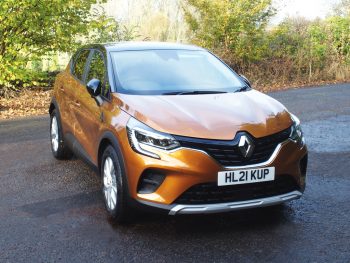Fleet World Fleet: Renault Captur Iconic E-Tech Hybrid 145 Auto
The multi-award winning Renault Captur compact crossover joins our long-term fleet. John Kendall reports back.

Since the Captur went on sale in 2013, it has become the best-selling Renault model in the UK
P11d (BIK): £23,630 (26%) MPG/CO2: 56.5 (combined) 114g/km Test MPG: 52.4mpg
I would be the first to say that the B-segment SUV was never designed for me, but you only need to take a look on the roads to see that I am hopelessly outnumbered. There is no shortage of them. The Captur story is similar to that for rival manufacturers – since the model went on sale in 2013, it has become the best-selling Renault model in the UK, with more than 150,000 finding buyers.
The second-generation Captur went on sale here in 2020, based on the new CMF-B modular platform, with hybrid models joining the range for the first time. The hybrid range consists of the E-Tech Hybrid 145 Auto and E-Tech Plug-In Hybrid 160 Auto. Our test model is the E-Tech Hybrid 145 Auto in Iconic trim. The petrol/electric system generates 142hp and
Iconic trim includes an array of safety features including lane keeping assist, lane departure warning and active emergency braking. Keyless entry is also standard, along with 7-inch touchscreen navigation a 4x20W amplifier, with DAB radio, ‘sound auditorium’, two USB sockets, wireless phone charging and Apple Car Play/Android Auto phone connectivity.
One of my first trips in the Captur was a 1,000-mile round trip to Scotland and back. It was a good way to find out what keeps buyers queuing for the Captur. The ride quality is clearly one of the factors. It is impressive for a comparatively short car and, even after several hours at the wheel, the seats also proved supportive and comfortable. The split boot compartment provides storage to keep items out of sight whether they are boots and shoes or laptops.
It takes a while to get used to the hybrid powertrain’s behaviour. It can switch from electric drive to coarse high-revving engine in a split second, even in Eco mode, which is a bit difficult to understand. On the way to Scotland, fuel consumption dropped to around 55mpg indicated, not far off the WLTP combined figure, but strong winds and heavy rain brought the figure down to around 51.5mpg at the end of the return journey, completed on just two tank fills with miles to spare. The ‘B’ regenerative brake boosting setting for the gear selector means you can just about eliminate brake pedal use in stop start traffic and undoubtedly helps to stretch fuel consumption.
So the Captur is off to a good start and would work well for many fleet car users with its combined comfort and low fuel consumption. We are looking forward to finding out what it’s like in the long term.












